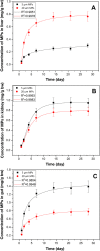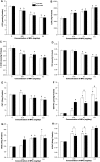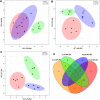Tissue accumulation of microplastics in mice and biomarker responses suggest widespread health risks of exposure
- PMID: 28436478
- PMCID: PMC5402289
- DOI: 10.1038/srep46687
Tissue accumulation of microplastics in mice and biomarker responses suggest widespread health risks of exposure
Abstract
Microplastics (MPs) are a significant environmental health issue and increasingly greater source of concern. MPs have been detected in oceans, rivers, sediments, sewages, soil and even table salts. MPs exposure on marine organisms and humans has been documented, but information about the toxicity of MPs in mammal is limited. Here we used fluorescent and pristine polystyrene microplastics (PS-MPs) particles with two diameters (5 μm and 20 μm) to investigate the tissue distribution, accumulation, and tissue-specific health risk of MPs in mice. Results indicated that MPs accumulated in liver, kidney and gut, with a tissue-accumulation kinetics and distribution pattern that was strongly depended on the MPs particle size. In addition, analyses of multiple biochemical biomarkers and metabolomic profiles suggested that MPs exposure induced disturbance of energy and lipid metabolism as well as oxidative stress. Interestingly, blood biomarkers of neurotoxicity were also altered. Our results uncovered the distribution and accumulation of MPs across mice tissues and revealed significant alteration in several biomarkers that indicate potential toxicity from MPs exposure. Collectively, our data provided new evidence for the adverse consequences of MPs.
Conflict of interest statement
The authors declare no competing financial interests.
Figures







Comment in
-
Uptake of microplastics and related health effects: a critical discussion of Deng et al., Scientific reports 7:46687, 2017.Arch Toxicol. 2019 Jan;93(1):219-220. doi: 10.1007/s00204-018-2367-9. Epub 2018 Nov 23. Arch Toxicol. 2019. PMID: 30470843 No abstract available.
-
Response to Uptake of microplastics and related health effects: a critical discussion of Deng et al., Scientific reports 7: 46687, 2017.Arch Toxicol. 2019 Jan;93(1):213-215. doi: 10.1007/s00204-018-2384-8. Epub 2019 Jan 2. Arch Toxicol. 2019. PMID: 30604140 No abstract available.
-
Plausibility of microplastic uptake in a paper by Deng et al., Scientific reports 7:46687, 2017.Arch Toxicol. 2019 Jan;93(1):217-218. doi: 10.1007/s00204-018-2383-9. Epub 2019 Jan 2. Arch Toxicol. 2019. PMID: 30604141 No abstract available.
References
-
- Rochman C. M. et al.. Policy: Classify plastic waste as hazardous. Nature 494, 169–171 (2013). - PubMed
-
- Cole M., Lindeque P., Fileman E., Halsband C. & Galloway T. S. The Impact of Polystyrene Microplastics on Feeding, Function and Fecundity in the Marine Copepod Calanus helgolandicus. Environ Sci Technol 49, 1130–1137 (2015). - PubMed
-
- Andrady A. L. Microplastics in the marine environment. Mar Pollut Bull 62, 1596–1605 (2011). - PubMed
-
- Lusher A. L., Hernandez-Milian G., O’Brien J., Berrow S., O’Connor I. & Officer R. Microplastic and macroplastic ingestion by a deep diving, oceanic cetacean: The True’s beaked whale Mesoplodon mirus. Environ Pollut 199, 185–191 (2015). - PubMed
Publication types
MeSH terms
Substances
LinkOut - more resources
Full Text Sources
Other Literature Sources

